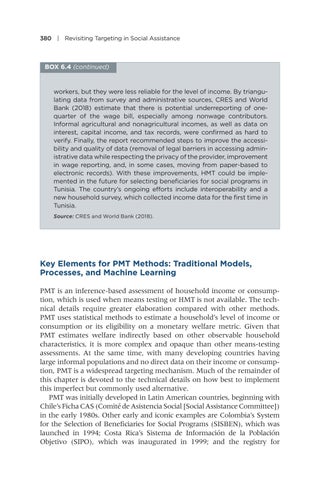380 | Revisiting Targeting in Social Assistance
BOX 6.4 (continued)
workers, but they were less reliable for the level of income. By triangulating data from survey and administrative sources, CRES and World Bank (2018) estimate that there is potential underreporting of onequarter of the wage bill, especially among nonwage contributors. Informal agricultural and nonagricultural incomes, as well as data on interest, capital income, and tax records, were confirmed as hard to verify. Finally, the report recommended steps to improve the accessibility and quality of data (removal of legal barriers in accessing administrative data while respecting the privacy of the provider, improvement in wage reporting, and, in some cases, moving from paper-based to electronic records). With these improvements, HMT could be implemented in the future for selecting beneficiaries for social programs in Tunisia. The country’s ongoing efforts include interoperability and a new household survey, which collected income data for the first time in Tunisia. Source: CRES and World Bank (2018).
Key Elements for PMT Methods: Traditional Models, Processes, and Machine Learning PMT is an inference-based assessment of household income or consumption, which is used when means testing or HMT is not available. The technical details require greater elaboration compared with other methods. PMT uses statistical methods to estimate a household’s level of income or consumption or its eligibility on a monetary welfare metric. Given that PMT estimates welfare indirectly based on other observable household characteristics, it is more complex and opaque than other means-testing assessments. At the same time, with many developing countries having large informal populations and no direct data on their income or consumption, PMT is a widespread targeting mechanism. Much of the remainder of this chapter is devoted to the technical details on how best to implement this imperfect but commonly used alternative. PMT was initially developed in Latin American countries, beginning with Chile’s Ficha CAS (Comité de Asistencia Social [Social Assistance Committee]) in the early 1980s. Other early and iconic examples are Colombia’s System for the Selection of Beneficiaries for Social Programs (SISBEN), which was launched in 1994; Costa Rica’s Sistema de Información de la Población Objetivo (SIPO), which was inaugurated in 1999; and the registry for


